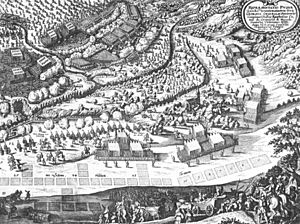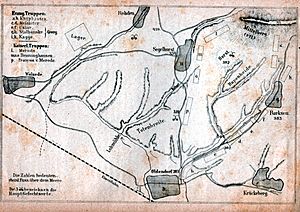Battle of Oldendorf facts for kids
Quick facts for kids Battle of Oldendorf |
|||||||
|---|---|---|---|---|---|---|---|
| Part of Thirty Years' War | |||||||
 |
|||||||
|
|||||||
| Belligerents | |||||||
| Commanders and leaders | |||||||
| Strength | |||||||
| 13,000, 37 guns | 14,700, 15 guns | ||||||
| Casualties and losses | |||||||
| 700 dead and wounded | 3,000 dead and wounded 1,000 captured |
||||||
The Battle of Oldendorf (also known as Schlacht bei Hessisch-Oldendorf) was a major fight during the Thirty Years' War. It happened on July 8, 1633, near Hessisch-Oldendorf, which is in modern-day Germany. This battle was between the Swedish Empire and its German allies, who were mostly Protestant, and the Holy Roman Empire. The Swedish side won a big victory.
Why the Battle Happened
The Thirty Years' War Background
The Battle of Oldendorf was part of the Thirty Years' War, a long conflict in Europe. This war lasted from 1618 to 1648. It involved many countries and was mainly about religion and power.
Hesse-Kassel's Role
William V was the ruler of Landgraviate of Hesse-Kassel. He was a Protestant and an ally of Sweden. His army had been fighting in areas like Westphalia and the Ruhr area. They were successful in weakening the presence of the Holy Roman Empire there.
The Siege of Hameln
Before the main battle, Swedish forces started to attack the town of Hameln. This town was held by the Imperial army. The Swedes began their attack in March 1633. They had help from troops from Hesse and Lüneburg. The Imperial defense of the Weser River area was led by Jost Maximilian von Gronsfeld.
The Battle of Oldendorf
Armies Meet Near Hessisch-Oldendorf
On July 8, 1633, the two armies met. The Swedish army was led by George, Duke of Brunswick-Lüneburg and Marshal Dodo zu Innhausen und Knyphausen. They faced an Imperial army. This Imperial army was led by Field Marshal Jobst Maximilian von Gronsfeld, Count Jean de Merode, and Lothar Dietrich Freiherr von Bönninghausen.
Who Fought on Each Side
The Imperial army had several groups:
- Merode commanded about 4,450 foot soldiers and 1,245 cavalry (soldiers on horseback).
- Bonninghausen led about 4,475 foot soldiers and 2,060 cavalry.
- Gronsfeld had 2,000 foot soldiers and 600 cavalry.
In total, the Imperial forces were slightly larger.
A Rare Double Attack
What made this battle special was that both armies attacked at the same time. This was very unusual during the Thirty Years' War. It only happened in a few other battles, like the Second Battle of Breitenfeld.
Key Commanders in Action
- The left side of the Swedish forces was led by Peter Melander. He was a general from Hesse-Kassel.
- Later, another Swedish general, Torsten Stålhandske, led a Swedish group of soldiers.
- On the Imperial side, Gottfried Huyn von Geleen also took part in the battle.
The Outcome
The battle was a clear victory for the Swedish and Hessian forces. Gronsfeld, one of the Imperial commanders, was captured. His part of the army was completely defeated by Melander's forces. The Imperial army suffered heavy losses. They had over 3,000 soldiers killed or wounded. Another 1,000 Imperial soldiers were captured. The Swedes, however, lost far fewer soldiers, with about 700 killed or wounded.
What Happened After
Impact on the War
The Swedish victory at Oldendorf was very important. It helped balance out some of their earlier defeats in the war. For a while in 1633, the Swedish and Imperial armies were quite evenly matched. This changed in 1634. Even though the Swedes won other battles, a big defeat at the Battle of Nördlingen in September 1634 shifted the power.
Political Changes
After the battle, Peter Melander, who fought for Sweden, tried to make a deal. He wanted Hesse-Kassel to join the Imperial army and sign the Peace of Prague. This peace treaty aimed to end the fighting between the Holy Roman Emperor and many Protestant states. However, Melander's plans did not work out. He left service in 1640 but returned in 1645 as an Imperial commander.
The Peace of Prague did bring many Protestant states, like the Electorate of Saxony, back to the Holy Roman Emperor's side. This meant Sweden and Hesse-Kassel were left fighting alone against a growing group of anti-Swedish forces. This situation eventually led France to join the Thirty Years' War.
Later Events in Hessisch-Oldendorf
Years later, in 1647, Hessisch-Oldendorf became a winter camp for the Swedish army. This army was led by Carl Gustaf Wrangel. They were retreating from Bohemia. The Imperial commander Melander then set up his own camp in Hesse.
Images for kids




